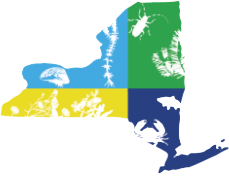Physiological responses of eastern hemlock (Tsuga canadensis) to light, adelgid infestation, and biological control: Implications for hemlock restoration.
Research Summary by Abby Bezrutczyk
Hemlock woolly adelgid (HWA, Adelges tsugae) infestations threaten the health of hemlock trees (Tsuga canadensis) and the surrounding ecosystem. While there are multiple biocontrol insects released and insecticides used to protect the hemlocks, these treatments may not be effective enough to mitigate negative impacts. Dr. Miniat and colleagues from the USDA Forest Service tested a silvicultural technique on hemlock trees in the field, in hopes that silviculture could be a complement to existing strategies to promote the persistence of HWA-stressed hemlocks. This particular technique– cutting down non-hemlock trees in a 15-meter radius around hemlocks– is thought to release the hemlock trees from light competition, giving the trees greater carbon storage and resilience to infestation. The researchers tested this technique on half the hemlocks at 3 forest sites: HWA-infested stands, uninfested stands, and stands with a HWA biocontrol agent (Sasajiscymnus tsugae)– leaving the other half of hemlocks as a reference. By measuring photosynthesis, leaf stress and carbohydrate concentration, shoot growth, HWA density, and basal area over 4 years, they found that their technique benefitted the trees in multiple ways. Trees in gaps, while still stressed by infestation, fixed twice the carbon and had greater shoot growth and basal area– likely due to the gap tree’s ability to photosynthesize the increased light and effectively allocate their resources during the times of low HWA-density. Interestingly, they did not see differences in HWA density between sites with and without biocontrol insects, and the presence of biocontrol insects did not confer a significant advantage to gap tree carbon fixation.
Take-home points:
- Creating canopy gaps increased the hemlock’s ability to fix carbon.
- This is likely because the increased light allowed for more photosynthesis and carbon fixation during low-HWA density seasons.
- Presence of biocontrol beetles did not confer an additional advantage in this case.
Management implications:
- Silvicultural release, by creating canopy gaps, could be a management practice in the future that complements insect biocontrol and insecticide use to protect hemlocks.
- Allowing the tree to grow in an open canopy can potentially slow the rate of tree decline.
- However, the researchers caution against this practice until follow-up research is done, to see if the findings in this study can apply more broadly.
Feature Image Credits: Hemlock woolly adelgid infestation on eastern hemlock, from Connecticut Agricultural Research Station

